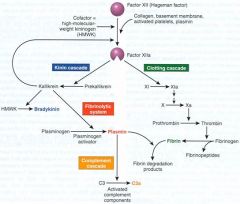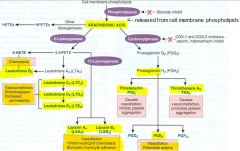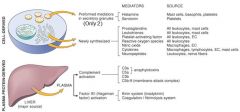![]()
![]()
![]()
Use LEFT and RIGHT arrow keys to navigate between flashcards;
Use UP and DOWN arrow keys to flip the card;
H to show hint;
A reads text to speech;
41 Cards in this Set
- Front
- Back
|
What are some chemical mediators of inflammation?
|
vasoactive amines, plasma proteases, arachidonic acid metabolites, platelet activating factor, cytokines and chemokines, nitric oxide, lysosomal contents, oxygen derived free radicals, neuropeptides.
|
|
|
What are 2 vasoactive amines?
|
-histamine
-serotonin |
|
|
What causes the release of vasoactive amines?
|
-physical injury
-immune reaction -anaphylatoxins C3a and C5a -etc |
|
|
What are the sources of vasoactive amines?
|
-mast cells - histamines
-platelets - histamine and serotonin |
|
|
What effects do vasoactive amines have in an inflammatory response?
|
-vasodilation
-increased vascular permeability -endothelial activation (histamine) |
|
|
Where are mast cells located?
|
in loose connective tissue near blood vessels in the skin, in the lining of the GI tract and airways
|
|
|
What are 4 groups of plasma proteases (cascade system)?
|
-complement system - activated by plasmin
-Kinin system - bradykinin - associated w/ pain ---activated by Hageman factor -clotting system - activated by Hageman factor -Fibrinolytic system |
|
|
What does the plasma protease Complement system comprise of?
|
C3a & C5a recruit leukocytes to destroy microbe
MAC (membrane attack complex) - lysis of microbe C3b - bacteria has receptor for C3b and it allows it to be phagocyzed. |
|
|
What does the plasma protease Clotting system comprise of?
|
-Activated by Hageman factor (Factor XII) which is activated by collagen and basement membrane
-Fibrin released (can leak into tissue w/ inflammation) |
|
|
What does the plasma protease Fibrinolytic system comprise of?
|
Fibrin degradation products
|
|
|
What are the pathways of the plasma protease cascade?
|

Factor XII (Hagemen's) activates Factor XIIa which activates both the clotting and kinin cascades. Following the clotting cascade acivates Fibrin. Following the Kinin cascade activates Bradykinin and moves into the Fibrinolytic System. The Fibrinolytic system activates Plasmin which degrades Fibrin and also activates the complement cascade - C3a
|
|
|
What is an Arachidonic acid?
|
20 carbon fatty acid w/ double bonds at C5, 8, 11, 14 (eicosatetraenoic acid)
|
|
|
What are the 2 main pathways of Arachidonic acid in inflammation?
|
-Cyclooxygenase produces prostaglandins
-5 lipoxygenases produces leukotrienes |
|
|
What drugs block which pathays of Arachidonic acid?
|
Corticosteroids block AA acid release from membranes - blocks both pathways (cyclooxygenase and lipoxygenase)
ASA and NSAIDs inhibit just cyclooygenase |
|
|
In Arachidonic acid metabolites, what does cyclooxygenase eventually do by producing portaglandins?
|

-PGE2 - vasodilation, potentiate edema
-PGI2 - vasodilation, inhibits platelet aggregation -TXA2 - vasoconstriction, promotes platelet aggregation |
|
|
In Arachidonic acid metabolites, what does lipoxygenase eventually do by producing leukotrienes?
|

- 5-HETE & LTB4 - chemotaxis
-LTC4, LTD4, & LTE4 - vasoconstriction, bronchospasm, increased permeability -LXA4 & LXB4 - vasodilation, inhibit neutrophil chemotaxis, stimulate monocyte adhesion |
|
|
What are the 3 isoforms of nitric oxide sythase and where are they located?
|
-eNOS - endothelial cells - this one reduces platelet adhesion
-nNOS - neural tissue -iNOS - (inducible) in macrophages |
|
|
What are some characteristics of Nitrous Oxide?
|
-short half-life ensures local action
-NO is a potent vasodilator and helps kills microorganisms -NO stored and can act quickly unlike prosteglandins and leukatrins which are made on demand |
|
|
What are Tachykinins?
|
rapidly acting neuropeptides
-substance P -Neurokinin A |
|
|
What are the sources of Tachykinins (neuropeptides)?
|
nerve fibers esp in GI tract and lungs
|
|
|
What are the actions of Tachykinins (neuropeptides)?
|
-Vasodilation
-Increased vascular permeability -Pain - rapidly induce gut tissue contraction (You get an amplified effect when all these actions act together) |
|
|
What 3 pathways can lead to opsinization with C3b, release of C3a, and formation of MAC?
|
-Alternative pathway (by C3b binding to microbe)
-Lectin pathway (via C3b binding to mannose-binding lectin on microbe) -Classical pathway (via C3b binding to antibody on microbe) |
|
|
What are the mophologic patterns of edema in inflammation?
|
-may be transient
-may have secondary waves -protein concentration can vary ---if the protein [ ] is low, it will not stain well on H&E. Cells appear separated and more spread out than in usual sections |
|
|
What is serous inflammation?
|
out pouring of thin fluid into tissue or bady cavity
-low protein concentration-transudate |
|
|
What is an example of serous inflammation and the causes and manifestation?
|
Blister in skin
-fluid accumulates w/in epidermis or between epidermis and dermis -Causes - mechanical trauma, burn, viral infection -when Viral infection is cause, the fluid filled space is called a VESSICLE |
|
|
What is fibrinous inflammation?
|
Fibrin is deposited - appears as an eosinophilic meshwork
-due to greater vascular permeability than that producing serous inflammation ---larger molecules including fibrinogen leak from vessel |
|
|
What is the precoagulant stimulus in fibrinous inflammation?
|
Tissue factor, collogen, etc. - start clotting cascade
-Fibrinogen is cleaved by thrombin to form Fibrin |
|
|
Where is Fibrinous inflammation seen and what is the end result?
|
Seen in body cavaties - pleural, peritoneal, and pericardial sac
Fibinolysis - resolves Scar - organizes |
|
|
What is suppurative inflammation?
|
Suppurative = purulent
-production of pus (purulent exudate) |
|
|
What causes suppurative inflammation and what does the pus consist of?
|
Pyogenic bacteria are most common - staphs and strepts
-neutrophils, edema fluid (exudate), necrotic cells ---acute appendicitis |
|
|
What is an abcess?
|
a focal collection of purulent inflammatory tissue.
|
|
|
What are the characteristics of an abcess?
|
-confined space
-central region contains necrotic tissue, exudates, and leukocytes -surrounded by a zone of neutrophils -outermost zone of vascular dilation and fibroblastic proliferation |
|
|
What is an ulcer?
|
a local defect or excavation of the surface of an organ or tissue (epithelium)
|
|
|
What causes an ulcer?
|
due to sloughing of inflammatory necrotic tissue:
-Mucosa (mouth, stomach, urinary tract) -Skin (pressure or circulatory disturbance) -Intense neutrophilic infiltrate (Can become chronic) |
|
|
What is cellulitis?
|
a diffuse acute inflammation that spreads along fascial planes
|
|
|
What is lymphangitis?
|
inflamed lymphatics
-lymphatics are endothelial lined, thin walled channels that help return tissue fluid to the systemic circulation |
|
|
What is lymphadenitis?
|
inflamed lymph node
|
|
|
What is bacteremia?
|
bacteria circulating in the blood
|
|
|
What is Hematogenous infectction?
|
occurs when circulating bacteria (bacteremia) seeds other organs
|
|
|
What is Septicemia?
|
systemic disease associated w/ the presence and persistence of pathogenic microorganisms or their toxins in the blood
|
|

|

|

